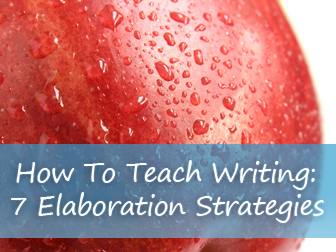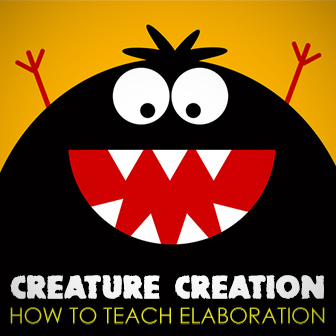How To Teach Writing: 7 Strategies for Elaboration


Sometimes ESL students lack detail in their writing. Whether it is because they do not know the vocabulary or do not feel comfortable writing long passages in English, all great writers must learn to overcome these hesitations and make their writing the best that it can be. Teaching elaboration does not have to be all theoretical and difficult to grasp. Here are some ways that I have taught my students to elaborate when they write, and the strategies are ones you can incorporate into your writing class today with no additional effort. I use these lessons in the context of a creative writing exercise dealing with imaginary creatures which I outline below.

Start your lesson by writing “elaborate” on the board. Ask your students if they know what it means. If they do not know the meaning, ask them what an elaborate painting might look like. Then tell them that the opposite would be a simple or plain painting. Once they have some idea of what elaborate means, give them this definition from dictionary.com: marked by intricate and often excessive detail; complicated.
While an elaborate painting may or may not be attractive, help your students understand that writers elaborate to make their writing more interesting and engaging for their readers. This means that the details that come from elaboration make a story interesting. All great writing uses elaboration.

Now that your students have an idea of something elaborate, it is time to create a class creature. This creature will be elaborate as well. Start by drawing a circle on the board, and tell your students that this is the creature that the class will work with. As a class, add detail to the creature. You may choose items like horns, a beak or feathers. You can give detail about the creature’s skin or feet or movement. As your class offers the details, you should draw them on the creature. In addition, write the words which describe these details either under the creature or in a list to the side of the creature. This can be a good time to introduce your students to some new and interesting vocabulary as the ideas come up.
Now that your creature is complete, ask your class how the blank circle is different from the completed animal. They may say the creature is more interesting, more realistic or that they can imagine it better. Help them understand that the details (or elaboration) are what makes the completed creature more interesting and that this is also true of their writing.

Now your students will have a chance to make their own detailed creatures. Starting with the same blank circle, each student should add his or her own details. At the same time, she should list the words that describe those specifics about her animal. If you like, you can make available any art materials you have on hand such as feathers, pipe cleaners, glitter or plastic eyes for your students to use.
Once your students have completed their creatures, let pairs show one another their creatures and describe what the animal is like.
Now your students will have a chance to be creative in their writing. Using the creature their imaginations created, your students will write a story using the following or a similar prompt.
The weather outside is strange and you notice a large black pool of smoke outside your backdoor. You walk outside and are transported to a word filled with strange creatures….
Have your students complete the story using their created creature. Encourage your students to use the following elaboration strategies as they write.
One way to elaborate is to give details as you write. Remind your students about the words they used to describe their creatures as they drew their pictures. These specific words that describe different elements of the creature’s body are details that will make their writing stronger and more interesting.
A more specific way to give detail as you write is to include words that relate to the five senses: sight, touch, taste, sound and smell. To help your students elaborate, you may want to brainstorm a list of words for each sense. Start with “sight” and make a class list of all the words that can describe how something looks (shiny, bright, red, wavy, etc.) Then make a list for each of the other senses. You might even want to have your students keep a running list in a vocabulary or writing notebook, or keep a class list on a poster in your classroom. Then when they write, challenge your students to include words from the lists that help the reader experience these senses. The goal is to make the reader feel as though he is in the middle of the story.
Similes and metaphors are elaboration strategies that compare one thing to another thing. When your students compare their creatures to a more familiar creature, their readers will feel like the imagined creature is more real. Does it roar like a lion? Does it slither like a snake? Challenge each student to include at least one sentence that compares his creature to another, well known animal. You may want to take a few minutes to remind your students that similes are comparisons that use “like” or “as” to describe two things. “He runs as fast as a cheetah.” Metaphors are comparisons that say one thing is another thing. “My mind was an ocean in a storm.” You may want to practice writing similes and metaphors with your students using their creatures before having them complete the writing prompt.
Another way to add elaboration in a piece of writing is to write dialogue or the specific words that a character spoke. If your students are familiar with how to write dialogue, challenge them to include specific things that their characters say as they write their stories. If your students are not familiar with writing quotations, review the specific punctuation that is used when writing someone’s exact words. You may want to incorporate a grammar lesson on reported speech when you are teaching your students how to write dialogue.
If a reader sees a specific instance where the writer uses specific detail, sensory words, comparisons or dialogue, have that person highlight the details as he or she reads. This will give your students a clear visual of how much elaboration they have used in their writing.
Give your students a chance to add more detail to their stories if they feel there is not enough, and then post the pictures with the stories on a bulletin board in your classroom or compile them into a classroom book. Your students will be inspired to use more detail in their future writing assignments when they see how their classmates have used successful elaboration in their own creature stories!